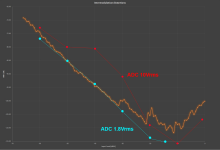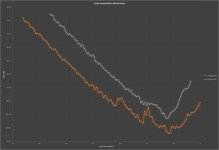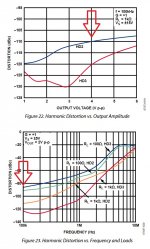I did replace OPA1612 for OPA1656, and also switched ADC input range for the 1.8Vrms and remeasured the range -15dbfs..-60dbfs. No hump at all and IMD of two devices together looks quite low, at least 3 times better vs DIY 9038PRO(which is 12x times more expensive vs 9038Q2M) 😉 I have to remeasure DR/SNR and THD+N as well, because OPA1656 is noticeable noisier than OPA1612.
Attachments
An interesting thing would be to see if you can find a way make the hump come back. I bet a lot of people would be interested in knowing where it comes from!...
As expected, DR is now worse for 2db than with OPA1612 128.8 vs 131db(A), THD+N -122.5db vs -124db. Pity, but I'll keep OPA1612 yet.
An interesting thing would be to see if you can find a way make the hump come back. I bet a lot of people would be interested in knowing where it comes from!...
I have soldered back OPA1612 and that fact doesn't affect the IMD absolutely. ADC's 10Vrms range makes that hump but why 1.8Vrms range has no hump shifted by 15db I have no idea..
ADC's 10Vrms range makes that hump but why 1.8Vrms range has no hump shifted by 15db I have no idea..
Is it the same input signal amplitude, but different ADC input ranges/attenuation?
Does the IMD test signal come from one DAC? Or you use 2 channels and add the signals to make sure they don't create IMD in the source?
Suggestion: input the same signal on left/right channel ; set one channel on the setting that makes the hump ; set one channel one the setting that does not. Acquire both channels at the same time, exact same input signal, so if the hump is absent in one channel, can be sure input signal is not to blame. Maybe something funny happens like channels interacting though? That would give information. Do both channels use the same AVCC reference?
Note the hump appears at levels that are suspiciously close to the point where the multibit ESS transitions to single bit.........
Suggestion: add a small DC offset, and see if that changes the hump. If the multibit still uses 6 bits then the LSB is 1/64 Fs ; a DC offset of 1/256Fs to 1/128 Fs should force it to switch between 2-level and 3 level modulation, maybe that will change things.
Last edited:
@IVX
What feeback resistors and capacitors do you use around the OPA1612/OPA1656?
It could be interesting to try the ADA4898-2 from ADI. It has a noise level, which is similar to the OPA1612.
I have seen a "hump" (on THD measurements) when using the OPA1612 with an AKM AK4493. It wasn't there with the LME49720. I wonder if there is some kind of issue with the OPA1612 at certain levels?
What feeback resistors and capacitors do you use around the OPA1612/OPA1656?
It could be interesting to try the ADA4898-2 from ADI. It has a noise level, which is similar to the OPA1612.
I have seen a "hump" (on THD measurements) when using the OPA1612 with an AKM AK4493. It wasn't there with the LME49720. I wonder if there is some kind of issue with the OPA1612 at certain levels?
ADA4898-2 is sold out everywhere and looks like that situation won't change until Q1 or Q2 2022. I wanted to try that one as well on my ES9028Pro board, but seems like that will have to wait. Octopart says RS has some in stock, but that is a lie. And no AliExpress gambles for me this time, not worth it.
Hi kn0ppers,
I've pasted a link to ADI's sample page. I don't know if this will work for you, but good luck.
ADA4898-2 Datasheet and Product Info | Analog Devices
I've pasted a link to ADI's sample page. I don't know if this will work for you, but good luck.
ADA4898-2 Datasheet and Product Info | Analog Devices
I did replace OPA1612 for OPA1656, and also switched ADC input range for the 1.8Vrms and remeasured the range -15dbfs..-60dbfs. No hump at all and IMD of two devices together looks quite low, at least 3 times better vs DIY 9038PRO(which is 12x times more expensive vs 9038Q2M) 😉 I have to remeasure DR/SNR and THD+N as well, because OPA1656 is noticeable noisier than OPA1612.
This is weird. 3 times better than the ES9038PRO 8 channels in parallel, with a much noisier op amp??? IMD measurements include noise, so unless you get DR, SHR and THD+N also x3 better, then your IMD measurements are wrong.
BTW, I checked OPA1656 in the IV stage and it was indeed much noisier than the OPA1612 and OPA1622, so I rejected it in that function. Due to the noise, it was indeed having a good effect in hiding the hump, but no effect in avoiding the hump.
BTW, my IMD measurements are analog, and 0dBFS = 4.2Veff differential (almost 12V peak-peak). My Rohde UPD is specified at -110dB IMD 1:4 7KHz+60Hz residuals, so my measurements are at the very limit of my instrument. The APx555 is the only instrument that can go down to about -117dB analog IMD, depending on your luck and the moon phase. I measured the ES9038PRO in an analog loop (digital in, digital out) with my noisy ADS127L01 ADC, but IMD doesn't go much under -105dB (no hump, though).
Last edited:
ADA4898-2 is sold out everywhere and looks like that situation won't change until Q1 or Q2 2022. I wanted to try that one as well on my ES9028Pro board, but seems like that will have to wait. Octopart says RS has some in stock, but that is a lie. And no AliExpress gambles for me this time, not worth it.
AD4898-2 won't work properly with ES9038PRO in stereo mode. It has a limited linear output current of 8mA (check the data sheet). Anything that is over 8mA will create also large amounts of THD and IMD, also shown in the data sheet. Even for ES9038QM2 it would be at the very limit in the THD.
For ES9038PRO with 2x4 channels in parallel, the only op amps that work fine (in the sense they are not limiting the DAC intrinsic performance) is OPA1622, or OPA1612 buffered with BUF634 to increase the output current capability. OPA1656 doesn't have enough linear output current too. Everything else I tried (quite a few) have either not enough output current, or too much distortions, or too noisy. I've settled for OPA1612+BUF634 as being the best (but also more expensive) solution.
I measured the ES9038PRO in an analog loop (digital in, digital out) with my noisy ADS127L01 ADC, but IMD doesn't go much under -105dB (no hump, though).
The measurement (normalized to the input level, the ADC takes maximum 2.5Vpp), it correlates very well with the ADS127L01 noise. That's where I hope to significantly improve the results, with the ES9822PRO ADC. BTW, the schematic (with 2xES9822PRO in mono mode) is almost complete, will go to the board house in September, after my 2021 vacation.
Attachments
What is analog IMD and digital IMD? What was your measurement setup? A little more context please!
8mA linear output current on ADA4898-2? 8mA is the quiescent current per channel, 40mA is the linear output current per channel. Output voltage swing into different loads is specified in Figure 34.
Also, I don't use ES9038Pro but ES9028Pro, 4 times higher output impedance, higher resulting feedback network impedance and easier load for the I/V OpAmp. Yes I know about the drawbacks, but ES9038Pro was sold out for a while so I settled with the 9028Pro for now.
Also, I don't use ES9038Pro but ES9028Pro, 4 times higher output impedance, higher resulting feedback network impedance and easier load for the I/V OpAmp. Yes I know about the drawbacks, but ES9038Pro was sold out for a while so I settled with the 9028Pro for now.
What is analog IMD and digital IMD? What was your measurement setup? A little more context please!
Analog IMD, Rohde Digital generator->PCM stream->DAC->Analog signal->Rohde analog analyzer.
Digital IMD: Rohde Digital generator->PCM stream->DAC->Analog signal->ADC->PCM stream->Rohde Digital analyzer.
8mA linear output current on ADA4898-2? 8mA is the quiescent current per channel, 40mA is the linear output current per channel. Output voltage swing into different loads is specified in Figure 34.
Also, I don't use ES9038Pro but ES9028Pro, 4 times higher output impedance, higher resulting feedback network impedance and easier load for the I/V OpAmp. Yes I know about the drawbacks, but ES9038Pro was sold out for a while so I settled with the 9028Pro for now.
Are we looking at the same datasheet?
I see ADA4898 having -110dB THD at 4Vpp (which is on the low side, to avoid degrading the DAC SNR) in 1K load. Your ES9028PRO needs a 200ohm I/V resistor for 4 channels in parallel, so in fact distortions will be significantly higher.
At 100ohm load (which is probably low for the ES9028PRO but still high for the ES9038PRO) and 2Vpp output, THD is about -90dB for both H2 and H3. Don't hope it will go much down under 100KHz, the curves are almost flat with frequency under 100KHz.
These numbers are making the ADA4898 completely improper for a high quality I/V stage. If you are using ES9028PRO, the OPA1612 will provide at least a 10dB THD improvement, and it will take the 200ohm I/V resistor load very well up to 5-6Vpp output. My ES9038PRO needs 50ohm I/V resistors, so the OPA1612 needs a current booster (which I settled for), or the OPA1622 opamp (1-2dB worse in overall THD).
Attachments
Yes we are looking at the same datasheet, but your first screenshot is from the +/-5V supply specs, same thing for figure 23. That is not to say that I find the distortion specs that impressive, after all there is a reason I didn't bother buying some for my OpAmp collection before they went out of stock everywhere 😉 OPA1612 is my go to OpAmp for low source impedances and it will probably stay that way, on my current layout I didn't even bother putting the exposed pad footprint for ADA4898 because I won't be able to by any in the near future.
I was wondering about something else as well: I own a Gustard X-16 (dual ES9068AS in Mono mode) and Gustard also uses OPA1612 on the I/V stage of the ES9068AS, but they are each accompanied by what looks like discrete buffers made up of BC847/57s and PZT2222/2907As. I haven't opened my unit to figure out the details (diamond buffers or SE class a followers with CCS loads?) but I will probably investigate that at some point. I might try something similar or just use IC buffers like you did. I see BUF634A now also comes in a more compact VSON 3x3mm package, should probably get some of those (who knows what might go out of stock next honestly).
I was wondering about something else as well: I own a Gustard X-16 (dual ES9068AS in Mono mode) and Gustard also uses OPA1612 on the I/V stage of the ES9068AS, but they are each accompanied by what looks like discrete buffers made up of BC847/57s and PZT2222/2907As. I haven't opened my unit to figure out the details (diamond buffers or SE class a followers with CCS loads?) but I will probably investigate that at some point. I might try something similar or just use IC buffers like you did. I see BUF634A now also comes in a more compact VSON 3x3mm package, should probably get some of those (who knows what might go out of stock next honestly).
Last edited:
The measurement (normalized to the input level, the ADC takes maximum 2.5Vpp), it correlates very well with the ADS127L01 noise. That's where I hope to significantly improve the results, with the ES9822PRO ADC. BTW, the schematic (with 2xES9822PRO in mono mode) is almost complete, will go to the board house in September, after my 2021 vacation.
For completeness and to better understand, I added to this chart the IMD floor of the Rohde (this is Digital generator->Digital analyzer).
It is now clear that noise dominates the IMD measurements, until the noise level crosses the IMD floor. From there, up to 0dBFS, the IMD distortion floor dominates the output. The IMD floor is about -127dB, while the noise drops with the same slope of almost exactly 10dB/decade, as in the previous IMD measurements, meaning that essentially there's no excess noise coming from the DAC. This is in my opinion a remarkable property of the ESS DAC and also shows that the ADS127L01 ADC is purely noisy, no funny noise shaping or any other tricks are used.. The added noise is almost pure white (wideband) noise.
So IVX, double check your measurement setup, something is wrong there.
Attachments
Last edited:
The setup is too simple to check it even once: USB-C- > DAC - > XLR - > ADC - > USB-C. I can feed it back to AP digital analyzer the Cosmos ADC stream by SPDIF, and check if ARTA dealing wrong with IMD. Cosmos DAC DR/SNR >128db, Cosmos ADC 126db unweighted, hence -116db levels are not a big deal.
Then how do you explain the IMD measurements by Amir @ASR on your DAC that you showed in post #877? It happens they are exactly what I would expect from an ES9038QM?
C’mon IVX, I understand your needs, but you are pushing it 😀.
C’mon IVX, I understand your needs, but you are pushing it 😀.
Last edited:
Talking about the ESS hump: I have concluded after tons of experimenting that the hump is there to stay; the only things that are really helping are the I/V stage bias shifting, and some adaptive clocking schema, that is, clock the ESS DAC at either x128 SR synchronous, or maximum x256 asynchronous, using the internal DPLL/ASRC. Fixed clocking @100MHz, for all sampling rates, will always more or less show the hump, at all sampling rates.
Everything else you will find is pretty much fluff; the RC series in parallel to the I/V resistor does nothing, it only provides some extra gain at HF, which is useless, unless you appreciate some extra noise to hide the hump. Lowering the I/V resistor simply lowers the I/V stage gain, therefore it lowers the SNR; the extra noise may hide some or all of the hump.
Everything else you will find is pretty much fluff; the RC series in parallel to the I/V resistor does nothing, it only provides some extra gain at HF, which is useless, unless you appreciate some extra noise to hide the hump. Lowering the I/V resistor simply lowers the I/V stage gain, therefore it lowers the SNR; the extra noise may hide some or all of the hump.
Last edited:
- Home
- Design & Build
- Equipment & Tools
- ADCs and DACs for audio instrumentation applications




